|
My first experience with a Walther pistol
was back when I was just a kid. My Uncle Dalton showed to
me a Walther P38 that he had brought home with him from Germany
at the end of World War II. He had picked it up off of a German
soldier who no longer had any use for it, and brought it home as
a war trophy. He seldom shot the P38, but when he let us kids
look at it, I was fascinated. It was made in 1944, and showed
signs of hurried manufacture. There were several tool marks, and
the finish wasnít the best, but the old pistol shot very well,
and was one hundred percent reliable with ball ammunition, which
was the only kind available to us then.
A couple of months ago, I was visiting
at the Smith & Wesson factory in Springfield,
Massachusetts. Along with Frank James and Leroy
Thompson, I was invited up there to look over some new
products that were scheduled for introduction this Summer by
S&W. All of the products shown to us were interesting, but
we all three perked up when they brought in the Walther PPS. Smith
& Wesson is the distributor for Walther products in the
USA, and they had three early samples of the PPS available for
us to shoot. PPS stands for Police Pistol Slim, in the typical
German way of naming weapons. It is a fitting title, as this is
one of the slimmest 9mm pistols in the world. In Germany, it
might be the ideal police pistol, but over here, I donít think
that you will see many of them riding in police duty holsters.
In fact, I donít think that you will see many of these new
pistols at all, because they will in most cases be carried
concealed. A pants pocket or inside-the-waistband holster is the
ideal world for a pistol as slim as this Walther. In fact, the
new PPS is almost exactly the same size as Waltherís own PPK/S
.380 auto, but the new PPS is chambered for the 9mm Luger
(9x19mm) cartridge, with the .40 S&W chambering to follow
soon. The PPS is even lighter than the PPK/S, weighing in
at 21.4 ounces with an empty magazine in place. The PPS uses a
plastic frame to achieve the light weight. Plastic pistol frames
have been in use for a couple of decades now, and have proven
themselves both durable and reliable. Loaded weight depends of
course upon the ammo chosen. The PPS is just barely over one
inch wide at its widest point; the slide release, and the slide
itself measures only .907 inch thick. The overall height of the
PPS is four and three-eighths inches, and the length is six and
one-third inches. In the pictures, you can easily see how
compact it is compared to the standard of all pocket guns: the five-shot
J-frame .38 Smith & Wesson revolver. The size of the
PPS is also very close to that of the little Kel-Tec
9mm PF-9. They are about the same height and thickness,
with the PPS being just slightly longer.
After a day of looking at the new products at
the S&W factory, the next day we headed off to the range. We
all wanted to try the PPS, and I was really impressed at how
easy it was to shoot accurately, and immediately started
hounding the Smith & Wesson marketing folks to get me a
production gun for testing. A few days ago the PPS arrived, and
I have been trying to wear it out ever since.
The PPS has a few unique features that are
worthy of mention, and are important to anyone thinking of
carrying the pistol for defensive purposes. A feature which I
really like is the ambidextrous magazine release. Being
left-handed, this is important to me. I also like the design of
the mag release, especially on a gun which might be carried in
the pocket. Instead of the traditional button magazine release,
the PPS has a lever that rides below and on both sides of the
trigger guard. Sometimes, button mags get pressed against the
wearerís leg or another object when carried in a pocket, and
the magazine gets released from its locked position. This can be
downright embarrassing in a fight; pulling out your pistol and
having the magazine hit the ground. With this Walther, that
ainít going to happen. The magazine is easily released by a
downward motion of the shooterís trigger finger. It works and
works well, releasing the magazine quickly, without any unwanted
magazine dumps. The PPS comes with two magazines; one that fits
flush with the bottom of the grip and holds six cartridges, and
another that has an extension at the bottom to accommodate the
little finger, and holds one additional round.
Another unique feature of the PPS is the
interchangeable backstraps. It comes with two; a small and
large, to adjust to better fit the hand of the shooter. The
backstrap pops off easily with the magazine removed, and it
renders the pistol inoperable until the backstrap is popped back
in place. Walther calls this the QuickSafe feature.
Remove the backstrap and no one can fire the pistol. It is a
good way to store the gun if you think little kids might get
hold of it, or in jurisdictions that require a handgun to stored
in an inoperable condition.
Stripping the PPS for cleaning is easy, and
requires no tools. It has take-down catches on either side of
the frame, much like a Glock
or S&W Sigma. The PPS has
long slide rails to support the slide during firing, and the
trigger pull measures a smooth five pounds, two ounces. It is a
striker-fired weapon, and the trigger travel is only about
one-third of an inch. It operates much like a Glock or M&P,
in that the striker is pre-cocked as the slide is operated,
either manually or upon firing, and the striker is fully cocked
by pulling the trigger, releasing the striker and firing the
weapon. There is a red indicator at the rear of the slide to
show the shooter the firing condition of the pistol. The slide
locks open after the magazine is emptied, and the slide release
falls easily under the thumb of a right-handed shooter, or can
be released with the trigger finger of a left-handed shooter.
The PPS has a captive recoil spring system consisting of dual
springs and a guide rod. In front of the trigger guard on the
frame is an accessory rail to mount a flashlight, laser, or
other device, if the owner desires such things hanging off the
bottom of the pistol. The barrel features an integral feed
ramp, and the case head is well-supported by the chamber.
For testing the PPS, I gathered up every brand
and type of 9mm ammo available to me. Most of it is Plus P rated
ammunition made for self defense, and any of it would serve well
for that purpose. I fired many rounds of each type for function
testing, and a few of each over the PACT chronograph for
velocity testing. The velocity readings are shown in
feet-per-second (fps), with the chronograph set eight feet from
the muzzle. JHP means jacketed hollowpoint. DPX is Cor-Bon
ammo loaded with the Barnes all-copper hollow nose
bullet. GDHP is Buffalo Bore ammo loaded with Speer
Gold Dot hollowpoint bullets. Glaser is a pre-fragmented
specialty bullet. FMJ is full metal jacket. HP is a
pre-fragmented hollowpoint bullet. EPR is a compressed tungsten
core bullet.
| Ammo |
Bullet Weight |
Velocity |
| Extreme Shock EPR |
115 |
1183 |
| Cor-Bon PowRBall |
100 |
1435 |
| Cor-Bon DPX |
115 |
1155 |
| Cor-Bon FMJ |
147 |
881 |
| Cor-Bon JHP |
115 |
1278 |
| Cor-Bon Glaser |
80 |
1490 |
| International Cartridge HP |
100 |
1155 |
| Buffalo Bore GDHP (24A) |
115 |
1316 |
| Buffalo Bore GDHP (24B) |
124 |
1217 |
| Buffalo Bore GDHP (24D) |
115 |
1223 |
I listed the item numbers on the Buffalo Bore
ammo because two different loads use the same 115 GDHP bullet,
but are loaded to different pressures. All of the loads
functioned perfectly in the PPS. There were no malfunctions of
any kind. Every load fed, fired, and ejected perfectly, and the
slide always locked open after the gun was empty. Even
with the high performance ammo tested, the little PPS was easy
to handle, as can be seen in the video of me shooting the gun.
For accuracy testing, I fired the PPS offhand at
seven yards and fifteen yards, and from an improvised rest at
twenty-five yards. It is easy to keep this weapon on target
shooting rapid fire drills. I was delighted with the accuracy of
the two pistols that I fired on the S&W range, and this
production gun is just as accurate. The PPS shot slightly to the
right for me, but that is easily corrected by moving the rear
sight to the left in its dovetail. The PPS comes supplied with
good, highly visible three-dot sights. I would like to see
tritium night sights offered as an option. Maybe they will do
that later. If not, perhaps Trijicon or another
aftermarket supplier will do so. I can think of no other
improvement for the PPS. It is a great little powerful pocket
pistol. Carrying it loaded with the standard magazine and the
extra mag loaded in the pocket gives fourteen rounds of Plus P
9mm firepower to its user. If attacked by some low-class thug,
or even a few of them, that should resolve most social conflicts
in short order.
I am glad to see the PPS on the market. It is
small, relatively light, and as flat as a book. It seems to be
built much better than some lightweight pocket autos on the
market. It exhibits a very high quality of manufacture. The
trigger pull is just about perfect for a gun of its type; much
better than the heavy pull weights on the PPK and PPK/S pistols.
It is a dandy little pocket gun, it is a Walther, and it is now
in production. I highly recommend it.
For more information and current pricing on the
PPS, go online to www.waltheramerica.com.
To order any of the ammunition shown here, go
to: www.cor-bon.com, www.extremeshockusa.net,
www.internationalcartridge.com
, or www.buffalobore.com.
Jeff Quinn
  
Got something to say about this article? Want to agree (or
disagree) with it? Click the following link to go to the GUNBlast Feedback Page.
|
Click pictures for a larger version.
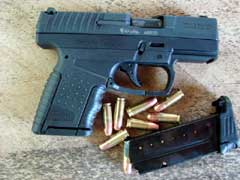
Waltherís New PPS 9mm Semi-Auto Pocket Gun.
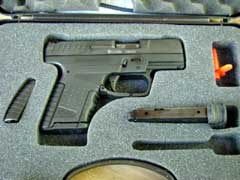
The Walther
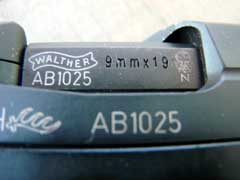
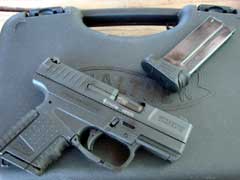
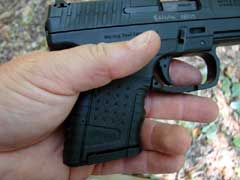

Magazines shipped with the gun include a six-shot and
extended seven-shot version.
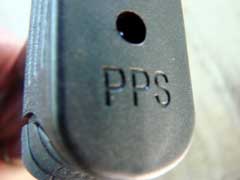
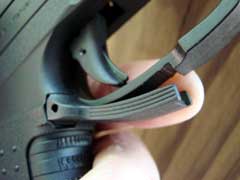
Magazine release is ambidextrous and well-designed.
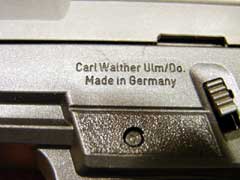


Take-down latch makes field stripping a snap.
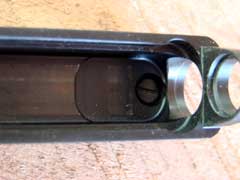
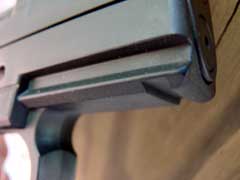
Frame includes an integral accessory rail.
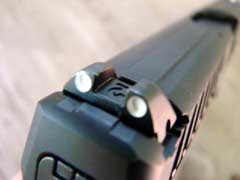
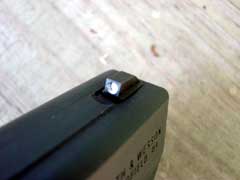
Sights are of a highly visible three-dot configuration.

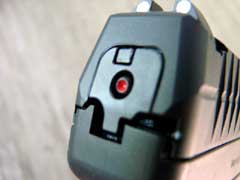
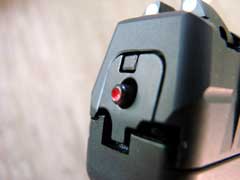
Cocking indicator is easy to see or feel, whether
decocked (top), cocked (center), or during the trigger pull
process (bottom).
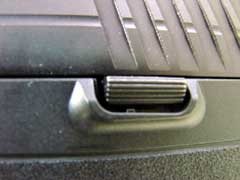
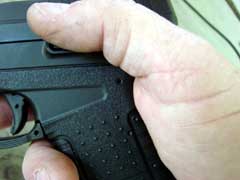
Slide release is easy to operate with either hand.


Two backstraps are included to allow the gun to be fit
to the shooter's hand. Removing the backstrap renders the gun
inoperable.
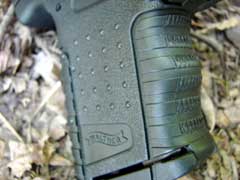
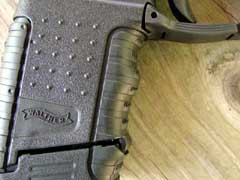

Small but rugged, the PPS is designed with robust
internal parts.
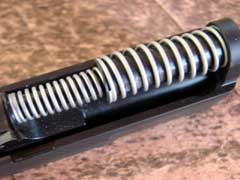
Recoil spring is a captured dual-spring unit.

Barrel gives great support to the case head.
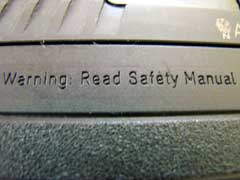
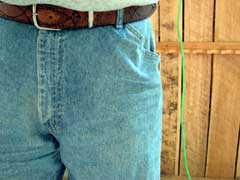
The PPS easily disappears into a pants pocket.

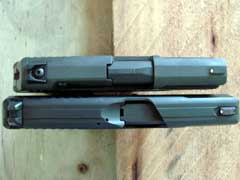
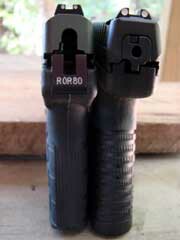
The PPS is similar in size to the Kel-Tec PF-9 (on top
in top picture, at top in center picture, and at left in
bottom picture).

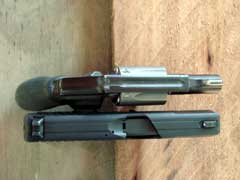
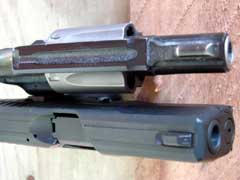
The PPS also compares favorably in size to Jeff's
S&W 342PD five-shot .38 snubby (on top in top picture, at
top in center and bottom picture).
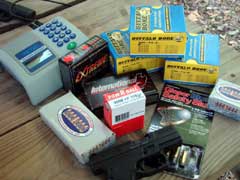
Jeff tested the PPS using a variety of ammunition, with
no failures of any kind.
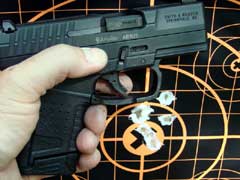

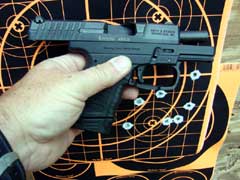
Groups fired at 7 yards offhand (top), 15 yards offhand
(center), and 25 yards rested (bottom) show the PPS to be
plenty accurate.
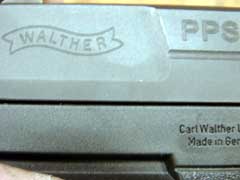
|
![]()